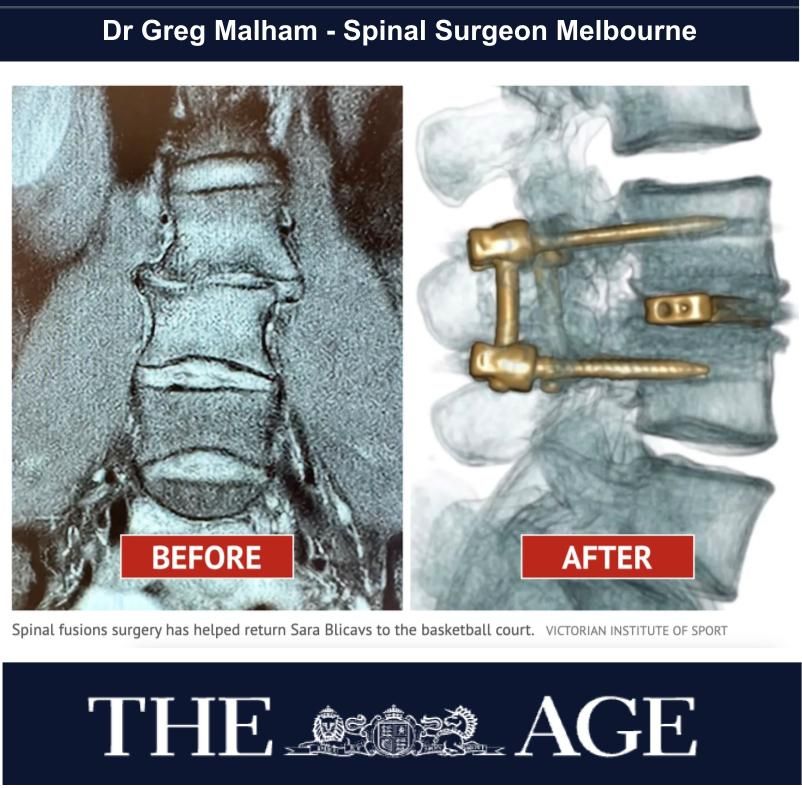News
'Fearful of sneezing’ -
How this Australian star came back from spinal fusion and a broken leg

Spinal fusion surgery has helped return Sara Blicavs to the basketball court.
By Brittany Busch the Age - The Age Newspaper - Updated May 8, 2025 — 5.00 am First published May 7, 2025 — 3.30 pm.
www.theage.com.au/sport/basketball/blicavs-and-the-bionic-back-how-this-australian-star-came-back-from-a-spinal-fusion-20250507-p5lx6v.html
WNBL champion Sara Blicavs knew something was wrong with her body. The 188-centimetre basketballer was losing mobility. Much smaller point guards were starting to push her out of the key, and she could not pick up her three-year-old nephew off the court. She ploughed on, desperate to attend the 2024 Paris Olympics with the Opals after getting a taste as an emergency substitute on the bronze medal-winning team in Tokyo.
The source of her pain was bilateral spinal fractures – cracks coming from both directions that met in the middle of her vertebra. The fractures caused movement that eroded the spinal disc away and left bone scraping on bone.
It meant she gave up her Paris dream and underwent a spinal fusion. After more than a year’s rehabilitation, she returned for the Opals on Wednesday night against New Zealand in Adelaide in an 18-point win over the Tall Ferns (88-70).
The 32-year-old said she had been so focused on the Olympics, she had blocked out the pain. Doctors later discovered she had also been playing basketball on a fracture in her tibia for months.
“You do end up kind of throwing your pain in the back of your head, and I was managing because I just wasn’t thinking about it. You choose to completely switch off that part of your brain, and ignore any sign,” she said in an interview with the Victorian Institute of Sport.
“I had a broken leg as well as a broken back.”
Blicavs' long road back
Sara Blicavs had spinal fusion surgery and disc replacement. A year later, she's back playing for the Opals, even though the surgery carried a risk that she would not be able to walk again. Source: Victorian Institute of Sport
The injuries took a toll. She had pins and needles down her right leg for half an hour after one game, and in a separate incident, was bedridden for days after her back seized when trying to get up off the ground while sunbathing.
But it was only when she decided to have surgery that she realised the extent of her injury.
“All the pain just flushed back in,” she said. “I couldn’t stand up ... I was fearful of sneezing. I couldn’t bend forward to pick a basketball up.”
The FIBA World Cup medallist now says that the complete spinal fusion and disc replacement last year was the best decision she’s ever made.
She said her “cocky bastard” of a surgeon assured her the prospects of competing again were good. Still, she was nervous about the invasive surgery, which had a 3 to 4 per cent chance of permanently impairing her mobility.
“You just never know what to expect. You’re getting a certain vertebra fused so you can’t move that vertebra anymore. It’s completely stuck in place, so it is scary,” she said.
Following the successful operation, Blicavs couldn’t bend or twist for three months, and could only sit or stand for half an hour. She moved back in with her mum for a few weeks, who had to help her lift more than five kilograms.
“It was a lot of lying down,” Blicavs said. “I got good at crossword puzzles and Sudokus.”
Sara Blicavs returned to the court for the Opals this week against the New Zealand Tall Ferns.
She got a scholarship with the Victorian Institute of Sport, where she was taught to run and move again in ways that wouldn’t overextend her back. When the VIS athlete progressed to doing high knees, she thought it was the best moment of her life.
Blicavs said a personal VIS team allowed her to develop as an individual athlete for the first time.
“It was a cool time to step away from training and playing with the team, focusing on yourself and building your game individually. I feel like I’ve improved greatly from where I was, not just with my body but even my skill level. It’s just given me so much passion for the future,” she said.
“I feel like a tennis player where I’ve got my little entourage, and I bring my physio, strength coach, here’s my running coach.”
She returned to the court for the first time in March for the Melbourne Tigers, almost a year before her surgery, in a nostalgic return after playing juniors at the club.
As she returned in Wednesday’s trans-Tasman series match, Blicavs takes nothing for granted.
“Just to be able to put the green and gold on again and be back in that team, I’ll never take that for granted,” she said. “I know I’m super lucky to even get the call-up.”
Blicavs said winning bronze in Tokyo had been an achievement, but she wasn’t done with the Olympics. Los Angeles in 2028 was now in her sights.
“I would love to be [in LA], but at the same time, I think what’s happened with my back has just made me realise that basketball’s just fun again.”

Spinal fusion surgery has helped return Sara Blicavs to the basketball court.



